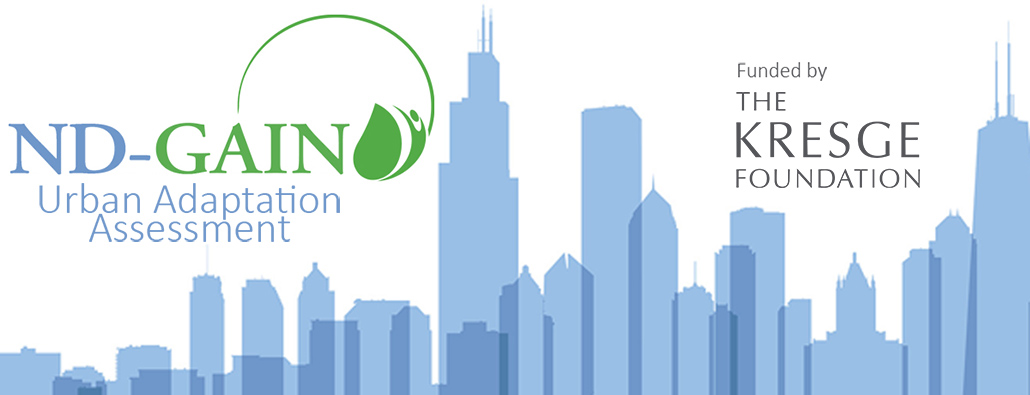The Urban Adaptation Assessment (UAA) Framework: Three Levels of Analysis
Continuing its effort at the country level to measure climate vulnerability and measure readiness to accept adaptation investment, Notre Dame Global Adaptation Index (ND-GAIN) now starts down-scaling the adaptation assessment to the city level. The Urban Adaptation Assessment project, funded by the Kresge Foundation and implemented by ND-GAIN, is focusing on building a framework that will enable cities to perform climate vulnerability assessments in support of setting climate change adaptation priorities. This 18-month project will put the assessment framework into practice in five pilot cities in the United States while also considering applicability abroad, specifically in developing countries.
Scale-wise adaptation is about using localized strategies aimed at the development of policies and activities to prepare for and adapt to the local impacts of climate change. The ND-GAIN country index, a flagship adaptation assessment, compares countries' climate impacts and capabilities to adapt. Down-scaling this assessment will help stakeholders to address adaptation decision making more thoroughly. The urban adaptation assessment aims to provide a measuring tool for city stakeholders to evaluate climate vulnerability and to direct adaptation actions.
As the framework for the Urban Adaptation Assessment (UAA) takes shape, ND-GAIN and its advisors are considering how best to capture the specific contexts of each city in the assessment. There are at least three challenges to address in assessing climate vulnerability and readiness to adapt at the city level:
- evaluation of baseline risks,
- adaptation gap analysis, and
- analysis of adaptive capacity.

The St. Louis skyline.
1. Evaluation of Baseline Risks
Cities greatly differ in the types of climate hazards they are confronted with as well as in their capacities to cope with the climate impacts of such hazards. A baseline study helps to understand what the potential risk consequence is of the climate hazards cities are potentially impacted by, as well as the capacities available to the city to respond and adapt to such impacts. Such baseline could facilitate monitoring the progress made in the course of developing more capacities for climate change adaptation. From the M&E point of view, a baseline study becomes even more crucial to test the theory of change. As said, there are two aspects of risk that require a baseline study:
- the baseline of the most likely hazards, and
- the baseline capabilities a city has to deal with the impacts.
The assessment of the first aspect is essentially an estimation of the consequence of the hazard (economic damage or impacted population) under a business-as-usual scenario. The baseline study of the second aspect evaluates the city's assets and capacities, upon which the future adaptation actions are built. A baseline study comprised of both the hazards and ‘adaptive capacity' roughly tells the degree to which a future hazard is going to cause impact if no additional action is taken. Each year, as a new assessment takes place, progress can be evaluated against the baseline measurement.
2. Adaptation Gap Analysis
The next question is, "How do we evaluate if the city is making enough progress?" Setting an adaptation target and measuring the adaptation gap – between the target and the reality of current adaptive capacity – offers a possible solution. Targets could either be outcome-oriented, measured by the reduction of economic losses and impacted population, or process-oriented, focusing on the improvement of capabilities to adapt. There are nascent investigations about this at the Country level (see UNEP). At the city scale it could be more challenging to identify comparable adaptation targets. Targets for the same indicator can vary among cities based upon the expectation of the public, available resources, institutional arrangements, existing governance structures, the type of hazards to address, etc. For instance, building codes for flood-prone areas differ from building codes for wind-prone cities. In addition, comparable data sources sometimes do not exist to facilitate the identification of one single target for different cities.
3. Analysis of Adaptive Capacity
While the Urban Adaptation Assessment should include individual city context, there are common features among cities that make direct comparison possible: social, economic and governance capacities that help to shape a variety of specific adaptive capacities. These factors do not necessarily have direct links to climate change, but could be the 'general features' of a system, or city, indicative of its 'generic capacity' to take adaptation actions (i.e. the availability of financial resources or the access to knowledge and technologies). The distinction between the specific adaptive capacity and generic capacity has only been established recently in the literature, but the idea of looking for common drivers of adaptation is not new. Essentially, 'generic capacities' determine the actions taken to enhance the 'specific adaptive capacities' that help to address climate risks (for example, education, as a general capacity, promotes the public awareness to prepare for climate disasters). An assessment framework that clearly considers both is rare, but it is important to allow for comparisons across geographies and the consideration of non-climate-related elements that influence city policy and market decisions.
The Urban Adaptation Assessment provides an opportunity to explore these unknown areas; the pilot study will test the feasibility and scalability of the types of analyses discussed above, thereby paving the way for an effective assessment tool.
Questions for the reader:
- Do you agree with the baseline analysis approach to compare the effects of cities taking action vs. a business-as-usual scenario?
- Do you think adaptation gap targets should be process-oriented, outcome-oriented, or both?
- Do you agree with quantifying ‘generic capacities' in order to compare across cities?




